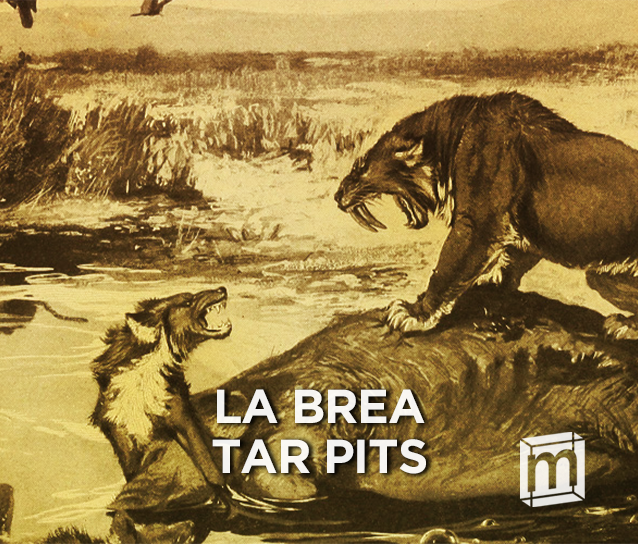La Brea Tar Pit Riker Box Specimens






La Brea Tar Pit Riker Box Specimens

























Above: The front of the Specimen Card for the Tar Pit Specimen. (Source: Smilodon californicus and Canis dirus fight over a Mammuthus columbi carcass in the La Brea Tar Pits, Robert Bruce Horsfall, 1913)
The La Brea Tar Pits are among the most well-known petroleum seeps in the world. Over millennia, such seeps can become lake-like formations and trap unwary wildlife. Excavated animal remains at La Brea comprise nearly 700 different species, some dating back 40,000 years to the Late Pleistocene.

📸 The La Brea Tar Pit Specimen
A Perserved Ecosystem
At the La Brea Tar Pits in California, remains of ancient life are found in the bubbling oil which reveal new information about what the planet used to be. Beetles, foxes, wolves, sabercats, and more have all been discovered preserved in the tar which paints an incredible picture of the Pleistocene ecosystem.
40,000 years ago, the La Brea Tar Pits were a natural formation of oil seeps that were masked with dead leaves and plants. When prey animals got caught in these seeps, larger predators could be drawn in and also trapped. Over time, the tar would bury them and seal their bodies in preserving material for thousands of years.

Crafted here at Mini Museum, this resin-infused specimen was created using material from a selection of mined La Brea Tar Pit material which contained the remains of coyotes, dung beetles, rabbits, and even a bald eagle.
The piece is enclosed in an acrylic specimen jar and ships in one of our small, classic riker cases. A small specimen card is included, which also serves as the certificate of authenticity.
Please Note: All of these specimens are products of petroleum seeps, as such, they will be oily and dirty. They will also smell faintly of charcoal or tar. Even the resin stabilization still exhibits some oiliness. We would recommend using gloves if you choose to handle the specimen outside its case.
Additionally, we do have some larger specimens from the Tar Pits available which contain fossils embedded in the matrix below.

MORE ABOUT Petroleum Seeps and La Brea
"We weren’t looking for stuff living in it." ~ John Harris, Paleontologist and Chief Curator at the Page Museum

📸 A Modern Day Petroleum Seep. Care for a swim?
How to make a tar pit
Dirt, leaves, or even water can cover the seep, turning the surface into a sticky trap. Once caught in the viscous tar, the animals die, though perhaps not without attracting other animals who prey on the remains and often become trapped as well.
Tar pits, also known as petroleum seeps, are formed by the hydrocarbons stored in deep oil and gas reservoirs leaking out of folded layers of sedimentary rock and bubbling upwards. This tar can squeeze through faults in the stone or in particularly porous rocks, rising to the surface and becoming a thick, sticky asphalt. Over many thousands of years, seeps can grow into large lakes, widening and pooling into deep areas of tar.
The remains from the La Brea Tar Pits speak to an ancient cycle of life and death. Yet, there are always surprises in science, and in 2007 scientists discovered living microbial communities deep within the hardened layers of tar. This unexpected find is leading to new ways of thinking about life here on Earth and elsewhere.

📸 Close-up image of the 1.95" Hydrophilus (scavenger water beetle) Specimen.
After the animal is consumed by the pit, its remains are surrounded with asphalt which protects them from weathering and decomposition. This allows for excellent preservation and fossilization, which often appears with a dark brown tint from the surrounding tar.
Due to the nature of the animal’s entrapment, clusters of fossils from many creatures of different species can often be found together. Ordinarily, predators will be found first, with the prey they chased below them. Common species include smilodons, dire wolves, coyotes, bison, ground sloths, as well as birds, insects, and reptiles.

Front of the Specimen Card

Back of the Specimen Card
Further Reading
VanValkenburgh, Blaire, and Fritz Hertel. "Tough times at La Brea: tooth breakage in large carnivores of the Late Pleistocene." Science 261.5120 (1993): 456-459.
Kim, Jong-Shik, and David E. Crowley. "Microbial diversity in natural asphalts of the Rancho La Brea Tar Pits." Applied and environmental microbiology 73.14 (2007): 4579-4591.
Gold, David A., et al. "Attempted DNA extraction from a Rancho La Brea Columbian mammoth (Mammuthus columbi): prospects for ancient DNA from asphalt deposits." Ecology and Evolution 4.4 (2014): 329-336.


























